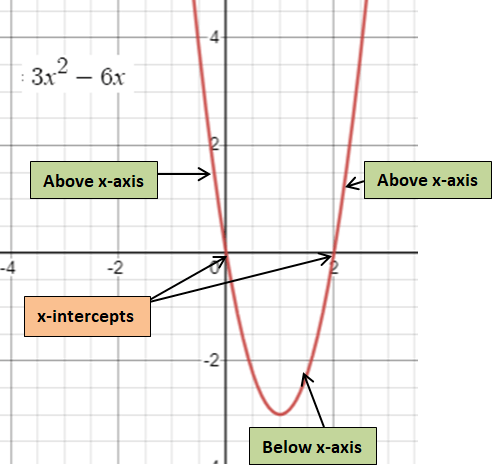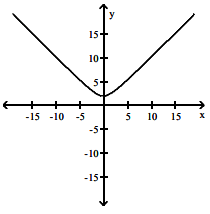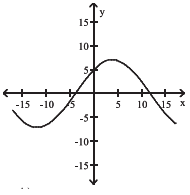FROM THE GRAPH OF THE FUNCTION FIND THE GRAPH OF ITS DERIVATIVE
Subscribe to our ▶️ YouTube channel 🔴 for the latest videos, updates, and tips.
How to match the graph of function f(x) to its derivative graph ?
The following points to be noted from the graph of original function.
- If the given function f(x) is increasing on the interval, then its derivative function will have positive slope and that should be above the x-axis.
- If the given function f(x) is decreasing on the interval, then its derivative function will have negative slope and that should be below the x-axis.
- The values that we are deriving by equating the first derivative to 0, that is f'(x) = 0 are critical numbers. These critical numbers are x-intercepts in the derivative graph.

|
From graph of f(x) (-∞, 0) --> Increasing (0, 2) --> Decreasing (2, ∞) --> Increasing At x = 0 and x = 2, there are critical numbers |
From graph of f'(x) (-∞, 0) --> above the x-axis (0, 2) --> below the x-axis (2, ∞) --> above the x-axis At x = 0 and x = 2, there are x-intercepts |

The graph of a function is given. Choose the answer that represents the graph of its derivative.
Problem 1 :


Solution :
In the question, the given curve is a parabola which will have the highest exponent of 2. So, its derivative will have the highest exponent of 1. Then it must be a straight line.
- On the interval (-∞, 0), the function is decreasing.
- On the interval (0, ∞), the function is increasing.
In the derivative graph the curve should be below the x-axis in the interval (-∞, 0).
In the derivative graph the curve should be above the x-axis in the interval (0, ∞).
So, option C is correct.
Problem 2 :


Solution :
Let us assume that the curve is intersecting x-axis on -1 and 1. It is clearly show it intersects the origin also.
|
From graph of f(x) (-∞, -1) --> Increasing (-1,1) --> Decreasing (1, ∞) --> Increasing At x = -1 and x = 1, there are critical numbers |
graph of f'(x) will be (-∞, -1) --> above x-axis (-1, 1) --> below x-axis (1, ∞) --> above x-axis At x = -1 and x = 1, there are x-intercepts |
So, option C is correct.
Problem 3 :


Solution :
|
From graph of f(x) (-∞, 0) --> Decreasing (0, ∞) --> Increasing At x = 0 there is a critical number |
graph of f'(x) will be (-∞, 0) --> below x-axis (0, ∞) --> above x-axis At x = 0 there is a x-intercept |
Both option B and D satisfies the above conditions, but considering the slope from the given graph it is very closer to 1. So, option D is correct.
Problem 4 :


Solution :
|
From graph of f(x) (-∞, -5) --> Increasing (-5, 0) --> Decreasing (0, 5) --> Increasing (5, ∞) --> Decreasing Critical numbers are -5, 0, 5 |
graph of f'(x) will be (-∞, -5) --> above x-axis (-5, 0) --> below x-axis (0, 5) --> above x-axis (5, ∞) --> below x-axis x-intercepts are -5, 0 and 5. |
So, option D is correct.
Problem 5 :


Solution :
|
From graph of f(x) (-∞, -11) --> Decreasing (-11, 1) --> Increasing (1, ∞) --> Decreasing Critical numbers are -11, 1 |
graph of f'(x) will be (-∞, -11) --> below x-axis (-11, 1) --> above x-axis (1, ∞) --> below x-axis x-intercepts are -11 and 1 |
So, option C is correct.
Problem 6 :
Given the graph of f, find any values of x which f' is not defined.

A) -3, 3 B) -2, 2 C) -3, 0, 3 D) -2, 0, 2
Solution:
At x = -2 and x = 2, we have sharp points. At sharp points its derivative is not defined. So, option B is correct.
Subscribe to our ▶️ YouTube channel 🔴 for the latest videos, updates, and tips.
Recent Articles
-
Finding Range of Values Inequality Problems
May 21, 24 08:51 PM
Finding Range of Values Inequality Problems -
Solving Two Step Inequality Word Problems
May 21, 24 08:51 AM
Solving Two Step Inequality Word Problems -
Exponential Function Context and Data Modeling
May 20, 24 10:45 PM
Exponential Function Context and Data Modeling